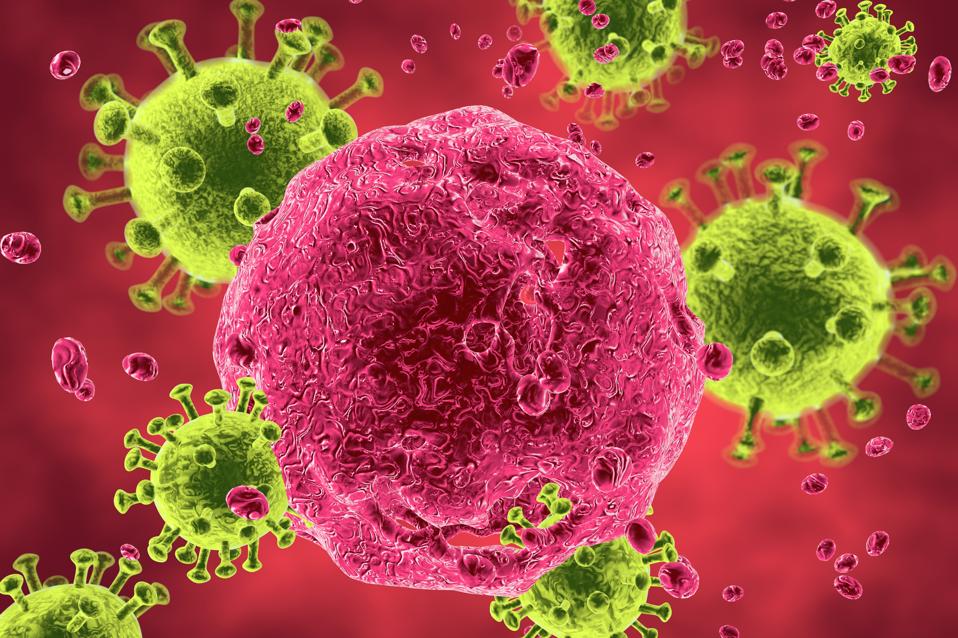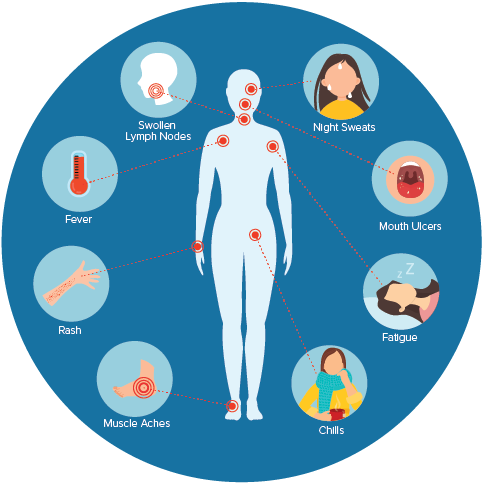Table of Contents
Viruses are microscopic infectious agents that grow or reproduce inside host cells. That is, they can multiply only after invading a cell of another living being. Their penetration can be done in many ways: inhalation, ingestion, injection, bite, piercing, or mucosal contact. Some viruses cause disease (pathogenic viruses), some don’t (nonpathogenic viruses). Pathogenic viruses can be responsible for less serious diseases (warts, minor respiratory infection) or serious diseases such as AIDS.
 HIV, human immunodeficiency virus, is the virus that causes AIDS.
HIV, human immunodeficiency virus, is the virus that causes AIDS.
The human immunodeficiency virus (HIV) is of the lentivirus subfamily, a genus of slow viruses belonging to the family of retroviruses. Lentivirus is a group of RNA viruses capable of replicating their RNA into DNA. In other words, they copy genetic information contained in their RNA in the form of DNA, by using a DNA polymerase enzyme called reverse transcriptase (RNA-dependent DNA polymerase). The reverse transcriptase then integrates into the DNA of the infected cell to be replicated by the DNA of healthy cells, proliferation of HIV or proliferation of HIV infected cells.
History of HIV/AIDS
Unlike many diseases, the discovery of AIDS is very recent, June 1981. The disease was discovered by the Centers for Disease Control and Prevention (CDC) in the United States after increased cases of Pneumocystis carinii pneumonia (PCP) and Kaposi sarcoma in the city of Los Angeles, San Francisco and New York. Since those patients were homosexuals, it was believed that AIDS was resulted from homosexuality practice; thus, in 1982, the disease was called Gay-related immune deficiency (GRID).
After numerous researches, scientists had discovered that other groups such as injection drug users, hemophiliacs and Haitians were infected; GRID was replaced by 4H, which stand for Haitians, homosexuals, hemophiliacs, and heroin users. The name 4H raised a lot of protestation not only in the homosexual community, but also among Haitians. After realizing that AIDS knows no boundaries, homo, hetero, children, young or old, black or white, man or woman, anybody can be affected by the pandemic, the CDC has agreed to use the name AIDS (Acquired immune deficiency syndrome) to refer to this incurable illness.
HIV / AIDS is now a major health concern all over the world; no region of the world seems to be escaped from this pandemic. The illness causes death and suffering to millions of people. Acquired Immunodeficiency Syndrome (AIDS) is considered as the leading cause of death from infectious disease in the adult population. Nearly 42 million people are affected in the world. The World Health Organization (WHO) estimate that AIDS has killed more than 25 million people since it was first discovered in June 1981, making it one of the most destructive pandemics in history. Without treatment, AIDS has a fatality rate of nearly 100%.
What Are the Causes of HIV/AIDS?
Transmission of HIV is usually done in three main ways: sexual contact, blood contact, and mother to child. To be transmitted, the virus must travel from an infected person through a biological liquid (blood, semen, preseminal fluid, vaginal secretions, or breast milk) to the body of another person by a mucous membrane, an open wound, a syringe, or an object cutting stained with contaminated blood.
Sexual transmission is the most common form of HIV transmission. There is no chance as some speculate; you have high risk to become infected if you have unprotected vaginal, anal or oral sex with an infected person. The virus can enter your body through the male sexual secretions (semen, pre-seminal fluid), vaginal secretions, or menstruation through the mucous membranes of the vagina, vulva, penis, anus or mouth. Once it enters, it enters for good! The wise choice is preventing yourself from being infected.
HIV makes no distinction of racial or social group. Everytime you have unprotected sex with a HIV carrier, you run the risk of contamination. If you have had unprotected sex, you may have been in contact and infected with HIV; you become a carrier without knowing it. If you suffer from a sexually transmitted disease (STD) such as syphilis, genital herpes, chlamydia, etc., you are much more vulnerable to HIV infection.
Pills, spermicides, IUD (Intrauterine Devices), implants, withdrawal before ejaculation, do not protect you against HIV or other STIs. Only condoms can save you from HIV infection. Do not ever forget to use latex condoms during sexual relations; that’s your only chance.
Transmission through infected blood – this form of transmission is highly contaminating, the risk is about 90%, both during blood transfusions or intravenous drug use. However, since the blood contamination in 1985, American authorities have taken strict preventive measures to ensure the quality of donated blood is safe, and prevent innocent people from HIV infection.
Sharing syringe or equipment used for injecting drugs, tattoo and body piercing is running a high risk of HIV infection. This risky practice can lead to not only HIV infection but also other health hazards associated with using intravenous drugs such as hepatitis B and C.
Mother-to-Child Transmission – there is a 25% chance for HIV-positive women to transmit the virus to their babies during the last weeks of pregnancy, childbirth or through breastfeeding. However, the risk decreases considerately when giving birth by caesarean section. To eliminate this risk, if you are HIV positive and are pregnant, talk to your obstetrician about caesarean delivery. In addition, instead of breast-feeding, consider other options to feed your infant.
Other forms of transmission – Although rare, you can have HIV through organ transplants, unsterilized dental or surgical equipments. This barely occurs, and when it does, it tends to be due to negligence. Therefore, before you have organ transplant or dental surgery, remember to inquire about their safety.
HIV symptoms and Warning Signs
Symptoms of HIV have several phases. The primary phase of the infection tends to develop within 15 to 30 days after the infection. Symptoms can include:
- Fever
- Sore throat
- Skin rash
- Swollen lymph nodes
- Headache.

Usually, an asymptomatic period fallows those symptoms. The asymptomatic phase can last from a few months to several years. Although the disease shows no signs or symptoms, you are still HIV positive, and can transmit the virus to others. Only blood screening, mostly done for other medical conditions, can establish the diagnosis of the infection.
During those years of silent, the HIV cells continue their proliferation, and the destruction of your normal cells. After years of fight, your immune system becomes unable keep up with the infection. The disease presents minor symptoms similar to those of common diseases. Depending on the vigor of your body, the following symptoms may take up to 10 years after infection to occur:
- Rapid weight loss
- Fever that lasts more than a month,
- Swollen lymph nodes of more than 1 cm,
- Chronic herpes lesions
- Thrush
- Sinusitis
- Pneumonia or unusual lung infections,
- Persistent diarrhea.
In the latest phase of the infection, also known as AIDS, major symptoms emerge. At this stage, your immune deficiency is severe damaged and is reflected in the occurrence of repeated serious infections. You become venerable to “opportunistic infection” (OIs), infection by germs that represent no threat to a normal person. During this last phase, you may have:
- Lack of energy
- Sore throat (caused by fungal infection)
- Excessive weight loss
- Fever accompanied with soaking night sweats
- Thick white deposit on your tongue or mouth (Candidiasis)
- Vaginal yeast infection
- Repeated acute or chronic pelvic inflammatory disease
- Extreme fatigue accompanied with headaches, dizziness and / or nausea
- Chronic diarrhea
- Injuring more easily than normal
- Swollen glands of the throat, armpits and groin swell
- Persistent dry cough
- Shortness of breath (dyspnea)
- Unexplained skin lesions
- Pain in your hands or feet
- Paralysis or loss of muscle strength and reflexes
- Temporary loss of consciousness
- Mental deterioration.
Children with HIV infection may experience:
- Mental Retardation
- Getting sick more often
- Difficulty to gain weight
- Difficulty to grow normally
- Walking difficulty
- Pneumonia and/or tonsillitis.
HIV Diagnosis
Getting tested for HIV is a personal and voluntary choice. The screening can be done at your request or with your agreement, if your doctor suggests it to you. It is an act of bio-medical confidentiality, protected by medical confidentiality; no physician or medical center should disclose your test result.
During the consultation, the role of the physician is to make you feel comfortable by explaining the importance of early testing; if you agree, he will prescribe appropriate diagnostic tests, mostly ELISA Test. Dialogue with your doctor will lead to the decision to prescribe the test or not.
HIV infection is revealed by the presence in your blood serum (watery liquid of your blood that separates when your blood clots) specific antibodies developed against the virus. The most common test available to do so is ELISA Test (Enzyme-Linked ImmunoSorbent Assay). Unfortunately, those antibodies are detectable only 6 to 12 weeks after infection; and ELISA test is not fully accurate, it can be falsely positive. A positive result must be controlled by the reaction of Western Blot (protein immunoblot), which is sensitive to proteins of the virus.
Is there a home test for HIV/AIDS?
Yes. Not long time ago, the Food and Drug Administration (FDA) has approved a test for HIV testing for use at home, Home Access HIV-1 test. The Home Access HIV-1 test gives you the result as accurate as a clinical test. In addition, your result, positive or negative, is automatically tested, making it more confidential.
If you wish to remain anonymous, you can choose the Home Access HIV-1 test, or visit a center where they offer Anonymous HIV Testing service. There are plenty of them in the USA; visit the medical center nearest you for more information.
Note:
1 – Being HIV positive does not mean you cannot have sex, but you must always use or ask your partner to use latex condom during penetration in order to prevent HIV transmission.
2 – If you are changing partner (s), it is suggested or even recommended to get tested (you and your new partner) for HIV before having sex, and before adopting the use of condoms in a stable relationship.
3 – Most people who find out that they are HIV infected tend to undergo major psychological disorder such as anger, guilt, denial, anxiety or depression. First thing you should do if you are diagnosed with HIV/AIDS is look for adequate support. Therefore, you should not hesitate to contact agencies that provide special support and advice to AIDS patients.
4 – Testing for HIV does not protect against the illness, it is just a method of detecting the presence or absence of the AIDS virus, at this moment, in your body. In case the result is negative, it will help you to establish a prevention strategy adapted to your life; if it is positive, this allows you to seek for early medical support, and follow an appropriate treatment.
HIV/AIDS Treatment
Current there is no cure or vaccine for AIDS. Treatments are aimed at slowing or preventing the progression of the disease. Taken as prescribed, along with a healthy lifestyle, those therapies can improve the quality of your life. However, the medications are more effective if offered as soon as possible after the diagnosis. That is why it is crucial to get tested for HIV regularly.
 The treatment of AIDS does not eliminate the risk of transmission. Once you are HIV infected, even in the asymptomatic phase of the illness, you can transmit the infection to others during unprotected sexual intercourse.
The treatment of AIDS does not eliminate the risk of transmission. Once you are HIV infected, even in the asymptomatic phase of the illness, you can transmit the infection to others during unprotected sexual intercourse.
If you are a pregnant woman being infected by HIV, you can still follow the treatment. Delivery and breastfeeding are two moments during which there are high risks of transmission to the child. The treatment, however, can reduce those risks when used as recommended. The risk of transmission of a pregnant woman under treatment to the child is now estimated at about 5%, very low comparably to 25% when you are not under treatment.
Currently, the primarily treatment of HIV/AIDS is antiretroviral (ARV) drugs, a class of drugs used for treating infections associated with retroviruses. This group of medications attacks HIV cells and stops or prevent the progression of the infection. Some of the most common include:
Nucleoside analogue reverse transcriptase inhibitors (NRTIs) – NRTIs are a range of antiviral drugs used to prevent viral replication in infected cells. Prolonged exposure of immunodeficiency virus (HIV) cells to Nucleoside Analogue Reverse Transcriptase Inhibitors (NRTIs) seems to significantly reduce their proliferation by inhibiting the “reverse transcriptase”, an HIV enzyme. However, using NRTIs alone is not recommended because of the risk of rapid emergence of resistance can be crossed between different molecules of this class. NRTIs include zidovudine (Retrovir), lamivudine (Epivir), didanosine (Videx), stavudine (Zerit), abacavir (Ziagen), and emtricitabine (Emtriva). By taking those drugs, you may experience fever, anemia, rash, fatigue, nausea, vomiting, diarrhea, abdominal pain, etc.
Protease inhibitors (PIs) – Protease inhibitors interfere with the final phase of viral replication. They block the enzyme protease to prevent formation of virus. Viruses produced are, therefore, unable to infect other cells. Some of protease inhibitors that are currently used in HIV treatment include saquinavir (Invirase), ritonavir (Norvir), indinavir (Crixivan) and nelfinavir (Viracept). Side effects reported include hyperglycemia, hemolytic anemia, spontaneous bleeding,
Non-nucleoside reverse transcriptase inhibitors (NNRTIs) – This class of drugs acts in the HIV reverse transcriptase but in different ways from nucleoside analogs. They block replication of HIV cells by binding directly to the enzyme reverse. Most common are: Nevirapine (Viramune), Delavirdine (Rescriptor), Efavirenz (Sustiva) and Etravirine (Intelence). Those drugs may cause rash, loss of appetite, headache, and fatigue.
Nucleotide reverse transcriptase inhibitors (NtRTIs) – These drugs inhibit the replication role of the enzyme reverse transcriptase, an enzyme that belongs exclusively to human deficiency virus. Nucleoside analogue reverse transcriptase inhibitors are AZT (zidovudine, Retrovir), ddC (zalcitabine, Hivid), ddI (didanosine, Videx), d4T (stavudine, Zerit) and 3TC (lamivudine, Epivir). NtRTIs may cause the following adverse effects: stomach discomfort, headache, insomnia, anemia, loss of appetite, headache, fatigue, nausea, vomiting, diarrhea, rash, and flatulence.
Fusion inhibitors – Those drugs prevent fusion between the envelope of HIV and the healthy cells membrane, which stop entry of the virus into healthy cells. The fusion inhibitors intervene at the time of penetration and blocking the protein gp41 from binding to the normal cytoplasmic membrane.
Currently, several drugs are under review by the FDA, but only enfuvirtide (Fuzeon) has received authorization by the U.S. market in 2003. His method of administration is subcutaneous injection. Enfuvirtide may cause constipation, diarrhea, dizziness, insomnia, loss of appetite, muscle pain, nausea, fatigue, and weakness.
Integrase inhibitors – Integrase inhibitors stop or slow the progression of the virus by blocking the integration of HIV DNA into human DNA. They are used in combination with other HIV drugs in patients who develop resistance to other treatments. Raltegravir (Isentress) is the only drug in this class approved to be used. Integrase inhibitors may cause diarrhea, nausea, fatigue, fever, and headache.
CCR5 Antagonists – also called Chemokine co-receptor inhibitors, CCR5 antagonists is a recent class of drugs used to treat CCR5-tropic HIV-1, a particular type of HIV infection. These drugs help to prevent the entry of HIV into normal cells. Maraviroc and vicriviroc are the two most common of those drugs. They may cause cough, fever, upper respiratory tract infections, rash, abdominal pain, and cardiovascular problems.
Note: if you eat a healthy diet (eat lots of fruits and cruciferous vegetable, no canned foods, no saturated fats) and exercise regularly you can significantly reduce or eliminate those adverse effects.
Alternative HIV Treatment
Note: regular complete body cleansing is strongly recommended if you are HIV positive. In addition, build your immune system, and increase the following vitamins supplements in your diet: selenium, L-Lysine, Omega 3, Coenzyme Q10, Alpha-Lipoic Acid, DHEA, Spirulina, Vitamins: A, B6, B12, E, C and Zinc
Herbs: Aloe Vera (overuse can cause fatigue), Cat’s Claw, Calendula, Green Tea, Olive Leaf, Ginseng, Catuaba, Bovine Colostrum
HIV/AIDS Prevention
Yes. To prevent HIV infection, follow these steps:
- Abstaining from sexual relationship
- Use a condom during intercourse
- Be faithful to your partner
- Never reuse or “share” syringes, water, or drug preparation equipment.
- Use a new, sterile syringe each time to prepare and inject drugs.
- Practice monogamous relationship
- Voluntarily, pregnant women should be tested for HIV to prevent mother-to-child transmission
- Health care providers should be very careful when dealing with HIV-infected blood.
Note: to learn more about AIDS, please visit http://www.aidsinfo.nih.gov
http://www.who.int/hiv/pub/casestudies/en/
Protease inhibitor side effects take people by surprise, PMID: 11364985 [PubMed ]
International Committee on Taxonomy of Viruses. 61.0.6. Lentivirus. National Institutes of Health.
http://www.hsph.harvard.edu/news/press-releases/archives/2004-releases/press06302004.html




